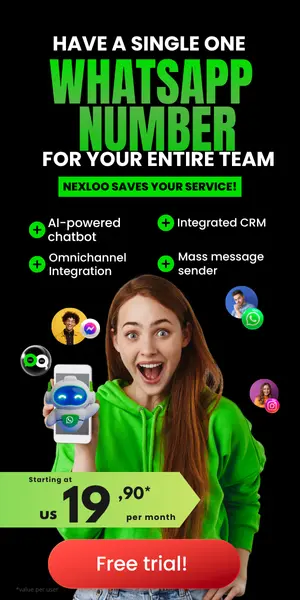In today’s fast-paced digital world, effective communication is key to maintaining a competitive edge. Enter WhatsApp for Business—a transformative tool that redefines how companies connect with their customers. With over two billion users worldwide, WhatsApp isn’t just another messaging app; it’s a dynamic platform with immense potential for businesses looking to enhance their communication strategies. Whether it’s addressing customer inquiries, sending notifications, or facilitating seamless interactions, WhatsApp offers a wealth of opportunities for businesses to thrive in a customer-centric market.
However, navigating the intricacies of the WhatsApp Business API can be daunting. This article will guide you through the essential aspects of leveraging this powerful tool, from understanding its features to implementing best practices that optimize your engagement efforts. As we delve deeper into each section, readers will discover actionable insights and strategies to master the art of customer communication through WhatsApp.
With an increasing number of businesses recognizing the value of direct, real-time engagement, the WhatsApp API stands out as a crucial element for enhancing customer relationships. Stay tuned as we unravel the key components of the WhatsApp API, providing you with the tools necessary to elevate your business communication to unprecedented heights.
Introduction to WhatsApp for Business
WhatsApp for Business is specifically designed to help businesses connect with their customers more efficiently. Unlike the standard WhatsApp application, the Business version enables companies to create a professional presence with a business account. This account allows businesses to showcase essential information such as their description, email address, and website. Such features help build credibility and improve customer trust as clients have a reliable means to reach out for support and inquiries.
Additionally, WhatsApp for Business includes messaging tools that are particularly useful for customer engagement. Automation, quick replies, and greeting messages are some of the tools that businesses can use to streamline their communication processes. Utilizing these features can significantly enhance customer interactions, making them faster and more productive. Moreover, businesses can label chats for better organization, ensuring timely responses to important inquiries.
For organizations aiming to stand out and foster stronger relationships with their customers, WhatsApp for Business provides the necessary infrastructure. By embracing this platform, businesses can cater to customer needs in real time, fostering a sense of loyalty and trust. The integration of the WhatsApp API further enhances this experience, allowing branded communications and interaction analytics that are essential for any modern business.
As we progress through this article, we’ll delve deeper into leveraging these fantastic capabilities of WhatsApp for Business, ensuring that you leave with a comprehensive understanding of how to utilize this powerful tool effectively.
Understanding the Official WhatsApp API
The official WhatsApp API serves as a critical element for businesses looking to engage with their customers on a larger scale. Unlike the standard app, the API allows greater customization and the ability to automate communication, which can lead to improved operational efficiencies. This integration is compatible with existing customer relationship management (CRM) systems, providing businesses with a holistic view of customer interactions.
One of the fundamental advantages of the WhatsApp API is the ability to manage a higher volume of messages without sacrificing personalization. Automated messaging can help businesses promptly respond to customer queries, saving time and resources. However, using the API requires careful planning and compliance with WhatsApp’s guidelines to prevent message spam and maintain user engagement.
Moreover, employing rich media options, such as images and videos, can enhance communication efforts by making them more engaging. Businesses can utilize these capabilities to provide customers with product overviews or promotional material, effectively generating more interest and engagement. By understanding and leveraging the WhatsApp API, organizations can tap into a powerful communication tool that meets modern consumer expectations.
Ultimately, the WhatsApp API is not just about sending messages; it’s about creating meaningful interactions with customers. Companies that master this platform will find themselves positioned as leaders in customer engagement and satisfaction.
Steps to Access the Official WhatsApp API
Accessing the official WhatsApp API requires businesses to undertake a structured process that ensures compliance and optimal utilization. The first step involves applying for access through the WhatsApp Business Manager. Here, businesses must provide crucial information about their organization, including business name and intended use of the API. It’s essential to clearly articulate the purpose of using the API—for help with customer service or notifications, for instance—to facilitate the approval process.
Once the application is submitted, it will undergo a review process where WhatsApp verifies the legitimacy of the business. Companies should be prepared for this scrutiny by ensuring they align with WhatsApp’s policies and standards. This often involves having a registered business entity and a robust communication strategy that justifies the use of the API.
After successfully obtaining approval, the next phase is selecting a Business Solution Provider (BSP). This provider acts as an intermediary between the business and WhatsApp, offering access to the API and additional support services. Choosing the right provider is crucial, as it can directly impact the implementation and management of the API.
Lastly, businesses must set up their systems to integrate the API effectively. This includes configuring their messaging templates and establishing a robust backend infrastructure. The integration phase can be complex, but it is vital to ensure a seamless communication process with customers, which ultimately enhances interactions and improves satisfaction rates.
Tips and Tricks for Optimizing WhatsApp Messaging
To maximize the potential of WhatsApp messaging, businesses should focus on refining their strategies to enhance engagement and responsiveness. One effective method is utilizing automated responses for frequently asked questions. By setting up chatbots that can handle common queries, businesses can free up human resources to respond to more complex inquiries, ultimately improving the efficiency of customer interaction.
Additionally, companies should ensure that their messaging is concise and targeted. Using quick replies allows businesses to engage customers more efficiently by providing instant answers or options. These tools not only enhance user experience but also ensure that communication remains relevant and personalized.
Another effective tactic is experimenting with rich media features, such as images, videos, and interactive buttons. These elements can significantly boost engagement levels, making communications more appealing to customers. Crafting visually engaging messages is an excellent way to stand out in a crowded messaging landscape.
Finally, businesses should regularly monitor and analyze their messaging performance. Keeping track of metrics such as response times, message open rates, and customer feedback provides valuable insights into what is working and what needs improvement. By leveraging these insights, businesses can continually refine their messaging strategies and ensure they are meeting their customers’ needs effectively.
Best Practices for Using WhatsApp as a Communication Platform
Adopting best practices when using WhatsApp for business communication is vital for maintaining professional integrity and customer satisfaction. First, businesses should ensure they adhere to WhatsApp’s policies regarding user consent. Obtaining consent before messaging customers establishes a respectful communication channel and can prevent potential account bans due to spam complaints.
Moreover, personalizing messages is crucial. Tailored communication not only enhances the customer experience but also helps build stronger relationships. By addressing customers by name and considering their history with the business, companies can foster loyalty and pacify frustrations during interactions.
Additionally, maintaining a good quality message score is imperative. Timely responses to messages can significantly impact the overall customer experience. Businesses must strive to communicate efficiently and effectively to uphold a positive reputation on the platform.
Fostering a proactive communication culture through updates, notifications, and engagement messages can also enhance customer satisfaction. This approach ensures that customers feel valued and informed, creating a strong connection between the business and its audience. Leveraging WhatsApp as a proactive communication tool enables businesses to excel in customer service while standing out in the competitive landscape.
Common Challenges and How to Overcome Them
While the WhatsApp API offers remarkable opportunities, businesses may face several challenges during implementation and use. One common issue is managing the volume of messages coming in. As businesses grow, the influx of messages can become overwhelming and impact response times. To combat this, employing automated responses and chatbots can help manage routine inquiries efficiently, ensuring that customers receive timely assistance.
Another challenge relates to policy compliance. Many businesses struggle to navigate the guidelines imposed by WhatsApp, which can lead to inadvertent policy violations. To mitigate this risk, organizations should invest time in understanding the rules and etiquette of using the platform. Regularly reviewing and updating messaging strategies in accordance with WhatsApp’s guidelines is essential for sustained success.
Additionally, businesses may face difficulties in customer engagement. With more brands vying for attention, finding innovative ways to capture customer interest can be a challenge. Utilizing multimedia elements, personalization, and unique promotions can significantly boost engagement rates and help businesses stand out in customers’ minds.
Lastly, analytics is crucial for understanding performance on the platform. Companies may struggle to interpret data from their messaging efforts. Employing analytics tools that provide insights into response times, conversion rates, and customer interactions enables businesses to make data-driven decisions that improve messaging effectiveness and overall customer experience.
Case Studies: Success Stories Using WhatsApp API
Several businesses have successfully leveraged the WhatsApp API to enhance their communication strategies and improve customer satisfaction. For instance, a retail company integrated the API to streamline its customer service operations. By implementing automated responses and quick reply buttons, the company effectively reduced response times from several hours to just a few minutes, which dramatically improved customer satisfaction rates.
Another notable case involves a travel agency that utilized WhatsApp to provide real-time updates to customers about their bookings. By sending crucial notifications such as flight changes or itinerary updates directly through the WhatsApp API, the agency enhanced customer trust and reduced the number of inquiries related to booking confirmations. This proactive approach not only improved customer experience but also optimized internal operations by decreasing the volume of incoming questions.
A financial services firm also tapped into the power of the WhatsApp API for marketing and customer engagement. By employing tailored message templates and rich media, they were able to send personalized investment tips and educational content to their clients. This strategy not only helped retain existing clients but also attracted new interest through referrals, demonstrating the efficacy of tailored communications.
These success stories illustrate that when businesses implement the WhatsApp API effectively, they can transform their operational workflows while enhancing customer interactions. Organizations are encouraged to explore similar strategies to unlock the full potential of this powerful communication channel.
Conclusion: The Future of Communication with WhatsApp
As the communication landscape continues to evolve, the WhatsApp API stands out as a powerful tool enabling businesses to interact with customers on a more personal level. The growing demand for real-time communication solutions emphasizes the need for companies to adopt platforms like WhatsApp, which offers speed, efficiency, and a user-friendly interface.
Moving forward, businesses are likely to harness the full potential of the WhatsApp API through continuous innovations in messaging strategies and customer engagement techniques. By integrating with AI-driven solutions, chatbots, and advanced analytics tools, organizations can ensure they remain at the forefront of digital communication.
Ultimately, the future of communication hinges on effectively leveraging platforms like WhatsApp to cultivate relationships, meet customer expectations, and enhance satisfaction. Companies that embrace these changes and adapt their strategies will not only improve their market standing but also thrive in an increasingly competitive landscape.
For businesses looking to elevate their communication efforts, obtaining the official WhatsApp API is a fundamental step. The seamless integration of this tool into everyday operations can empower businesses to create richer customer interactions and achieve sustainable success. Discover how empowering your business with a CRM for WhatsApp can enhance your reach and efficiency.









